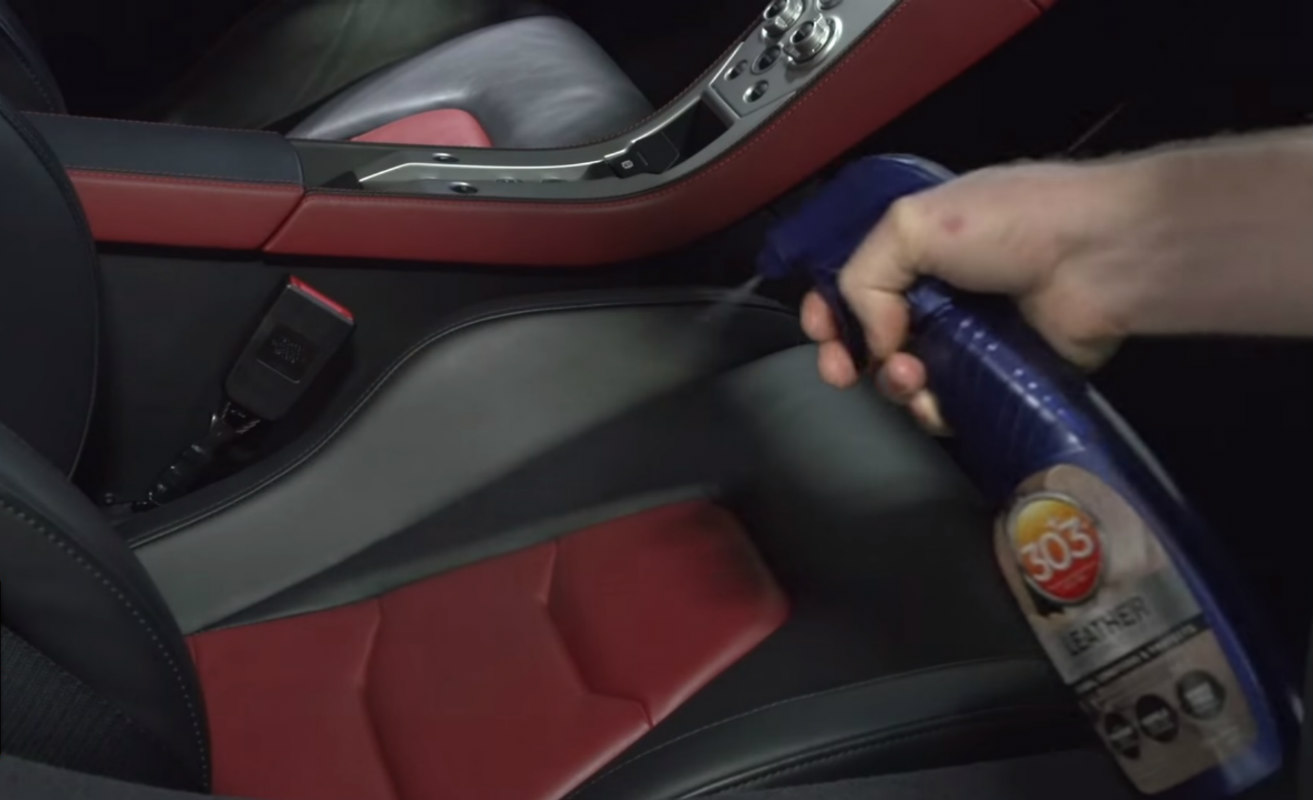5 Tips to Clean Car Upholstery
Motorists and enthusiasts who value their vehicles may benefit from learning more about the proper way to clean car upholstery. Anyone who has children or spends a significant amount of time inside their vehicles understands how messy automobiles can get in a short amount of time. The most effective tools, solvents and techniques are often the highest priorities identified by the leading brands in the automotive industry. Recognizing that different upholstery materials require different cleaning methods is also incredibly important for maintaining the quality of the vehicle.
Car Cleaning Tools
Certain materials featured on the vehicle’s interior may require using more than one type of cleaner to get the job done. Many enthusiasts prefer using products like 303® Automotive Leather 3-in-1 Complete Care for their upholstery cleaner. For cloth upholstery, many professionals recommend trying 303® Fabric Guard™ or Spot Cleaner. Some of the different types of tools needed to completely clean the car upholstery include carpet cleaners, glass cleaners, rags, paper towels, scrub brushes and a vacuum. Paint thinner may be effective in cleaning some of the harder stains on the upholstery; just make sure to test it out first because the chemicals can discolor some fabrics.
For the more difficult stains, mechanic’s hand cleaner, alcohol, specialty products and foaming cleaner are typically recommended. Road tar and grease from shoes can create the most difficult spots to get out of the car upholstery. Biodegradable mechanic’s hand cleaner typically works well on these types of greasy stains. Some hairsprays may be effective in getting pen marks out of the car upholstery as well. Baking soda is a household product used by many people for cleaning the carpet inside the vehicle interior.
Car Cleaning Techniques
Most cleaning products recommend testing on an inconspicuous place to ensure the cleaner is compatible with the vehicle’s interior. The cleaner being used should be sprayed directly on a soft, clean rag before rubbing the dirty areas. Once the major spots are cleaned, Q-tips can be used to tidy up the edges and crevices lining the vehicle’s interior. Putting in this extra effort epitomizes what detailing a vehicle is all about. Glass cleaner on a rag or paper towel is good for cleaning the inside windows, windshield and plastic surfaces. In order to reduce the impact of future stains, use the 303® Fabric Guard™ or another type of starch to spray down the cleaned fabric. Once the car’s carpet has been cleaned thoroughly, use floor mats to help minimize the dirt that collects in the fabric time.
Caring for Leather and Vinyl Upholstery
Many vehicles feature leather on the seats and surfaces containing dye that wears away with time. Thin layers of wear or fading color may be treated conditioners and cleaners like 303® Automotive Leather 3-in-1 Complete Care that are actually designed specifically for leather. Once the leather begins to crack or wears out completely, the entire seat cover may need to be replaced. It’s also beneficial to be careful around the sewn stitching holding the leather upholstery together, especially with the steering wheel.
When rubbing the area with the 3-in-1 Complete Care product, if it doesn’t seem to make any improvement, that section of leather may already be too faded or worn out. If this is the case, try leather dying the fading spot or the entire section can be replaced. For a more thorough cleaning, consider using a toothbrush with soft bristle to help get out the dirt and grime still trapped in leather grain. This can be accomplished by applying the new toothbrush in a circular motion slowly over the leather surfaces found throughout the entire interior.
Caring for Cloth and Fabric Upholstery
With fabrics or cloth materials, the first step in cleaning the car upholstery is to vacuum the entire area. Getting the dirt and debris out first can help reduce the risk of excess abrasion ruining the fabric when you scrub it clean. Use a foaming spray interior cleaner on the seats on other similar areas, but it’s important to confirm that the product is compatible with the material being cleaned. Once the fabric has been covered in cleaning foam, use a wet sponge to wipe it down. The next step is to use a soft, clean rag to wipe away any excess residue and let the fabric dry out. Once the cloth is dry, the interior should be vacuumed again.
Carpet and Trouble Spot Cleaning
Spots and stains on the carpet should also be addressed when cleaning the car’s upholstery. The first step in the process is using a vacuum to get all the excess dirt and debris that has collected in the carpet fibers over time. After vacuuming, spray the trouble spots with 303® Spot Cleaner until they are soaked. A bristle brush can be used to clean the dirty spots, but the dirtiest sections may need to be scrubbed repeatedly. Any residue lifted off the carpet should be wiped up with a clean cloth. Once the cleaner has dried, the carpet should be vacuumed again. For superficial stains, a basic carpet cleaner equipped with a scrub cap should be effective at getting basic stains out of the upholstery.
When something like candy, gum, crayons or other sticky substances are attached to the upholstery, the first step is to stop the melting by using ice. Remove as much of the sticky substance from the seat as possible once it hardens. Some have had success using light heat from an iron resting on a paper towel placed over the stain. Once the sticky substance is reheated, it may be soaked into the paper towel, just be sure not to spread or rub it around if it doesn’t come right up. Repeatedly blotting the area with a paper towel is much more effective than trying to rub sticky stains off the upholstery.
Cleaning the car upholstery properly can help an old vehicle look brand new again. Spending time on completely cleaning the upholstery with an attention to detail can be relatively easy with the right tools and techniques. Taking the time to remove everything from the vehicle and gather all the tools and cleaners in one place is often the most advisable approach. In order to avoid any serious mishaps or mistakes, it’s best to take the time to test all the products in small areas or on other materials before applying them to the fabric or leather on the vehicle’s interior. When the car upholstery cleaning is done correctly, half a day’s work can help the oldest and dirtiest vehicles look brand new for the remainder of the year.








My Uncle Herman recently handed down one of his classic cars to me and I want to know how to maintain it as much as possible. It really helped when you gave examples on how to remove things like crayon stains, gum, and candy from the car interior because I can bet that any one of us who brings our kids along on a car ride with that car will end up having those kinds of items litter the seats and floor of the car. I’ll be sure to remember the rest of your tips while looking for a place that I can buy fresh car mats I can use to replace the current old ones. Thank you!
Hi after a crash my exhaust has been coming into the car cab staining the ceiling. The car is now repaired but what should I use to remove the stains please?